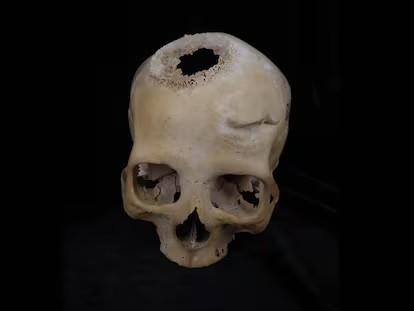29/05/2024
29/05/2024

LONDON, May 29: New evidence from a 4,000-year-old skull suggests that ancient Egyptian physicians may have attempted to treat cancer surgically. This finding challenges the notion that cancer is primarily a modern disease.
The skull, belonging to a man who died at the age of 30-35, is housed in the Duckworth Laboratory collection at the University of Cambridge. It dates back to between 2686 BC and 2345 BC and is labeled 236 in the collection. For over a century, scientists have noted multiple lesions on the skull, indicative of bone damage from malignant tumors. However, recent digital microscopy and micro-computed tomography (CT) scans have revealed cut marks around these tumors, suggesting that ancient healers used sharp metal instruments to remove the growths.
“This is the first evidence of humanity surgically addressing what we now call cancer,” said Dr. Edgard Camarós, a professor at the University of Santiago de Compostela in Spain, and senior author of the study published in Frontiers in Medicine. The study raises questions about whether the surgeries were performed on living patients or posthumously for medical study. “If the cut marks were made while the person was alive, it suggests a direct treatment for cancer. If posthumous, it indicates an early form of medical autopsy,” Camarós explained.
These findings highlight the sophistication of ancient Egyptian medicine, as documented in texts like the Ebers Papyrus and the Kahun Papyrus. Dr. Ibrahem Badr, an associate professor at Misr University for Science and Technology in Giza, Egypt, who was not involved in the research, stated, “Ancient Egyptian medicine was not solely based on herbal remedies but also relied on surgical practices.”
The study utilized advanced 21st-century technologies, such as CT scans, to reveal details previously unknown about ancient medical practices. “This research transitions our understanding from archaeological possibilities to scientific and medical certainty,” Badr said.
The researchers also examined a second skull from the Duckworth collection, labeled E270, which belonged to a woman who died between 664 BC and 343 BC. While this skull also showed signs of cancer, it did not display evidence of surgical intervention. However, the woman’s skull contained long-healed fractures, indicating successful medical treatment for head injuries.
Dr. Badr, who collaborates with international scientists to study diseases in ancient mummies, emphasized the importance of reevaluating Egyptian medical history using modern technologies. “By utilizing these modern techniques, we will gain a more comprehensive and precise understanding of medicine in ancient Egypt,” he said.
The new findings add a significant chapter to the history of cancer. “The more we look into our past, the more we know that cancer was much more prevalent than we thought,” Camarós said. The study also provides context for ancient Egyptian perceptions of cancer, which focused on the visible tumors produced by the disease. The earliest recorded observation of cancer is in the Edwin Smith Surgical Papyrus, dating back to around 3000 BC to 2500 BC, which includes a case study describing breast cancer but notes a lack of treatment options.
The incisions around the skull tumors suggest that ancient healers were attempting to either treat the disease or understand it better for future treatment. “This represents a milestone in the history of medicine,” Camarós concluded.


